
Rattus is a genus of muroid rodents, all typically called rats. However, the term rat can also be applied to rodent species outside of this genus.

The Asian palm civet, also called common palm civet, toddy cat and musang, is a viverrid native to South and Southeast Asia. Since 2008, it is IUCN Red Listed as Least Concern as it accommodates to a broad range of habitats. It is widely distributed with large populations that in 2008 were thought unlikely to be declining. It is threatened by poaching for the illegal wildlife trade.
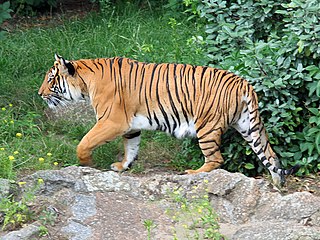
The Indochinese tiger is a population of the Panthera tigris tigris subspecies that is native to Southeast Asia. This population occurs in Myanmar and Thailand. In 2011, the population was thought to comprise 342 individuals, including 85 in Myanmar and 20 in Vietnam, with the largest population unit surviving in Thailand, estimated at 189 to 252 individuals during the period 2009 to 2014.

The silver pheasant is a species of pheasant found in forests, mainly in mountains, of mainland Southeast Asia and eastern and southern China. It is introduced on Victoria Island in Nahuel Huapi Lake, Neuquén, Argentina and on Vancouver Island, Canada. The male is black and white, while the female is mainly brown. Both sexes have a bare red face and red legs. It is common in aviculture, and overall also remains common in the wild, but some of its subspecies are rare and threatened.

Red-cheeked squirrels are species of squirrels in the genus Dremomys in the subfamily Callosciurinae. The six species which are all found only in Asia are listed as "Least Concern" by the IUCN.

The back-striped weasel, also called the stripe-backed weasel, is a weasel widely distributed in Southeastern Asia. It is listed as Least Concern on the IUCN Red List in view of its presumed large population, occurrence in many protected areas, apparent tolerance to some degree of habitat modification and hunting pressure.
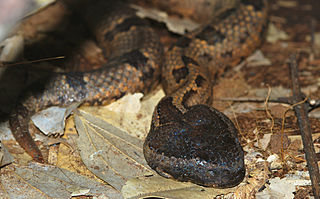
Ovophis monticola, commonly known as the Chinese mountain pit viper, is a pit viper species found in Asia. Currently, two subspecies are recognized, including the nominate subspecies described here. Recent taxonomic work suggests that most of these should be considered as separate species. IUCN has already evaluated O. m. makazayazaya as Ovophis makazayazaya.

The Amboina box turtle or Southeast Asian box turtle is a species of Asian box turtle widely distributed across Southeast Asia. It is native to the Asian mainland from northeast India, through Bangladesh, Burma and Thailand, across Laos, Cambodia, Vietnam, and Malaysia. It is also found on the archipelagos of Indonesia and the Philippines.

Oldham's leaf turtle is a species of turtle in the family Geoemydidae.

Epeus is a genus of the spider family Salticidae. They are often found on broad-leaved plants or shrubs of rain forest, or in gardens of Southeast Asia.

The masked palm civet, also called the gem-faced civet or Himalayan palm civet, is a viverrid species native to the Indian subcontinent and Southeast Asia. It has been listed as least concern on the IUCN Red List since 2008 as it occurs in many protected areas, is tolerant to some degree of habitat modification, and widely distributed with presumed large populations that are unlikely to be declining.
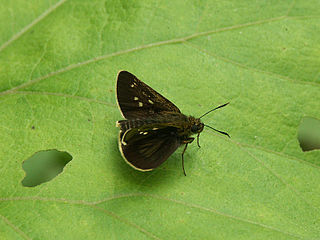
Thoressa is a genus of skipper butterflies erected by Charles Swinhoe in 1913. They are commonly known as "aces" or "ace butterflies". The genus is endemic to Southeast Asia with many species endemic to China.

Père David's vole is a species of rodent in the family Cricetidae. It is found in China, Myanmar, Taiwan, India, Vietnam, and Thailand. This species is a member of the melanogaster group, one of the two main groups of Eothenomys voles. Its dorsal pelage is dark brown, often nearly black, and the ventral pelage is gray, sometimes brown. The tail is shorter than the body. This species is found in pine/rhododendron forests.
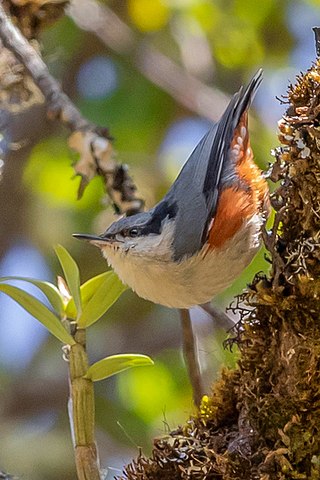
The chestnut-vented nuthatch is a species of bird in the nuthatch family Sittidae. It is a medium-sized nuthatch, measuring 12.5–14 cm (4.9–5.5 in) in length. The upperparts are a solid grey-blue, with a markedly black loral stripe. The underparts are uniform grey to buff from the throat to belly, with brick red on the flanks. The undertail is white with a rufous border. The chestnut-vented nuthatch utters different kinds of calls, which can sometimes sound like a wren alarm, and its song is a monotonous, stereotypical crackle, typically chichichichi. Its ecology is poorly known, but it probably feeds on small arthropods and seeds, and the breeding season begins between March and May. The nest is typically located in a hole in the trunk of a tree, and the clutch has two to five eggs.

The chestnut-capped babbler is a passerine bird of the family Timaliidae. It is monotypic within the genus Timalia.

The Chinese goral, also known as the grey long-tailed goral or central Chinese goral, is a species of goral, a small goat-like ungulate, native to mountainous regions of Myanmar, China, India, Thailand, Vietnam, and possibly Laos. In some parts of its range, it is overhunted. The International Union for Conservation of Nature has listed it as a "vulnerable species".

Marumba cristata, the common striped hawkmoth, is a species of moth of the family Sphingidae. It is found from the Himalaya, through Nepal and north-east India, Myanmar, southern and central China to western Malaysia (Sundaland).
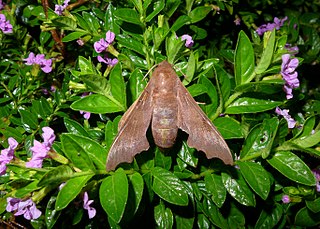
Cypa decolor is a species of moth of the family Sphingidae first described by Francis Walker in 1856.
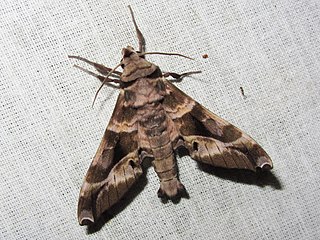
Craspedortha porphyria is a species of moth of the family Sphingidae.
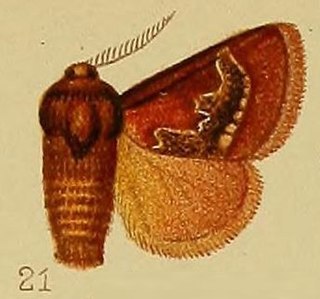
Miresa is a genus of moths in the family Limacodidae described by Francis Walker in 1855.




















